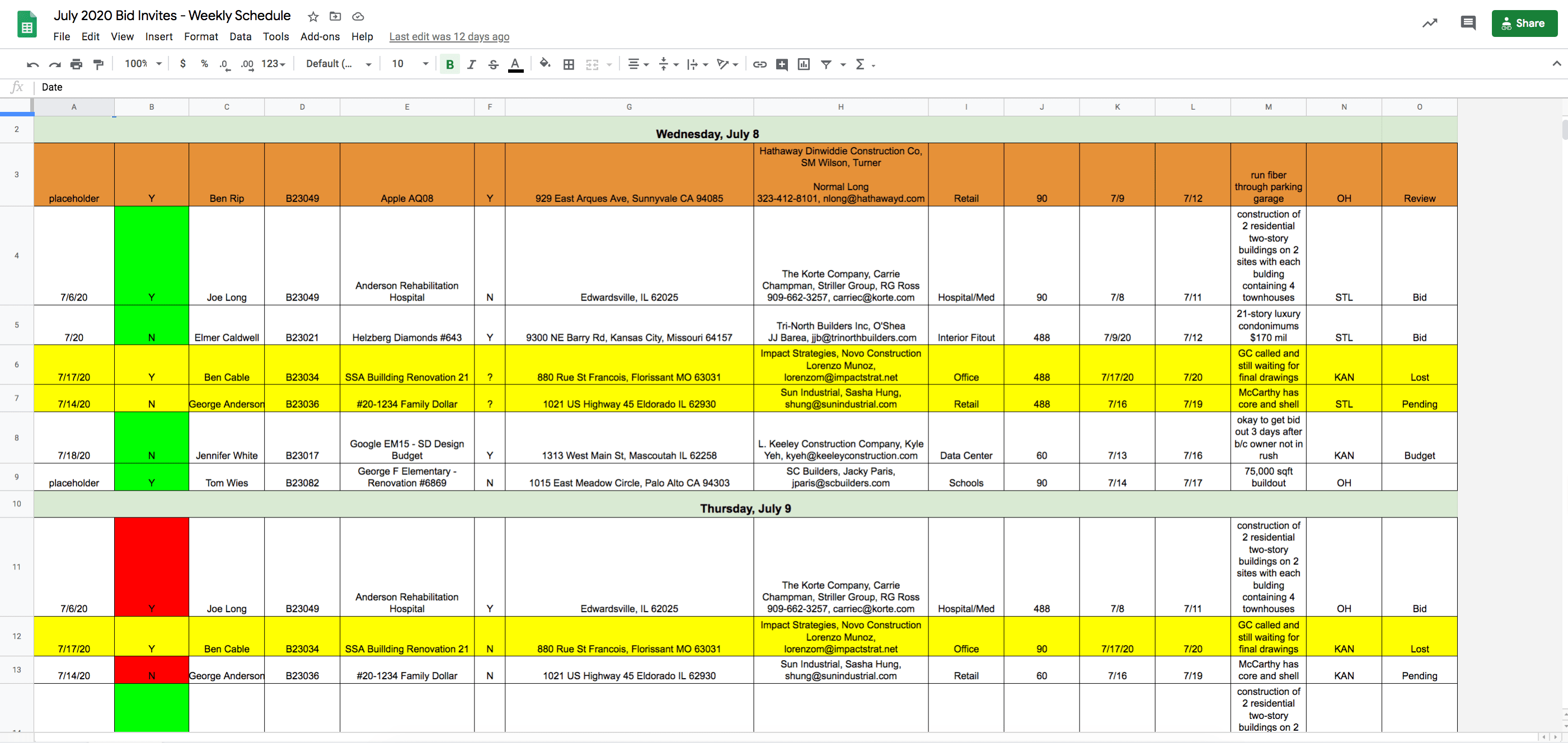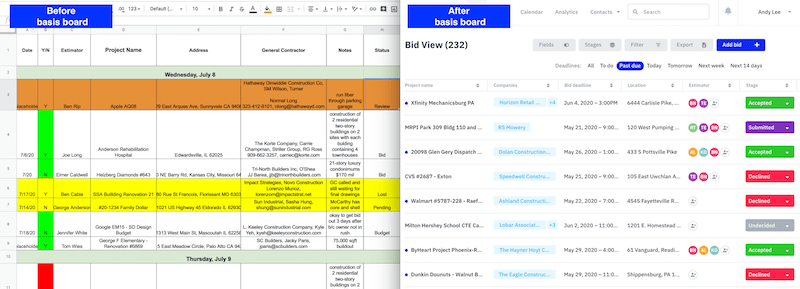4 non-obvious ways to improve your bid board
Written by Andy Lee

This is a 3-part series on how to improve your estimating process. This is part 1 and it covers how to improve your existing bid spreadsheet.
Everyday estimating teams are bombarded with 100s of emails (bid invites, addendas, updates) and it's not uncommon for estimators to spend half their days sifting through emails, updating bid boards. By the time every bid is tracked neatly in a spreadsheet, the day is half over. In this article, we'll discuss:
- Challenges with using traditional methods to track bids
- How to build a process around what to track
- How to eliminate data-entry by moving to an online bid board
- Using a centralized inbox to prevent mistakes
- Replacing Excel with cloud-based spreadsheets for robust tracking
 Almost every contractor has seen a bid board like this
Almost every contractor has seen a bid board like this
Challenges of tracking bids
Most subcontractors adopt similar processes for tracking their bid invites. They use a bid tracker spreadsheet template and manuarlly input the data. This is such a labor intensive task that it's become common to see subcontrontractors hire specific roles (bid coordinator/administrator), solely for managing incoming bid invites. Everyday someone on the estimating team needs to
- Monitor the estimating inbox
- Access plans from dozens of different planrooms
- Manually transcribe info from email into spreadsheet
- Update the spreadsheet everytime an addendum is received
- Notify the group that the spreadsheet has been updated
As with any process or job involving manual data entry, mistakes with data quality and communication occur
- Two estimators might bid the same project and send different pricing to a GC
- You forget to include a GC on a project with 5-6 GCs bidding
- You scramble to revise your proposal on bid day after seeing an addenda last minute
- A colleague leaves for vacation and you have no idea what he is working on
One of our customers described this process as slow and fraught with errors
“When you add 30 new bids, that’s 30 new lines that you needed to copy and paste into the spreadsheet while ensuring you did not alter the cell formatting. Using a manual entry spreadsheet was tedious and labor-intensive.”
- Erich Ruhmann (Negwer Door Contracting, Missouri's largest door contractor)
Solutions
After talking with 40+ estimating teams and learning about their estimating process, we've identified 3 strategies for solving a subcontractor's bid-tracking problems.
Track the right things at the right time
For subcontractors who prefer to manually enter bids into a spreadsheet, it is important to decide what information will be tracked. The more information you track, the more data you will have to understand your business (e.g. break down profit margins by GC or trade). At the same time, tracking more information means more data-entry.
Bid information that is time-sensitive should be kept up-to-date at all times. This includes information like
- Bid/RFI deadlines
- Job walk dates
- Pre bid meetings
- Last Addendum noted
- Stage of bid (estimating, submitted, awarded, lost)
- Next scheduled step + follow up date
- GCs bidding
- Assignee
Other fields are important for analyzing bids over the long-run, but not time-sensitive. This information should be updated prior to submittal once you know exactly what the bid is. This includes information like
- Market-sector
- Bid vs budget
- Quote amount
- Margin
- Competitors
We recommend that subcontractors block off parts of the days to check emails and update the spreadsheet. For example, an hour in the morning, 30 minutes at lunch, and 30 minutes before you leave the office can ensure no bids slip through the cracks. Most contractors adopt this consistency because it leads to fewer mistakes and better focus on the team. It is also equally important to communicate the latest bid board, or any updates with your team on a daily basis. This way, estimators know exactly which plans to reference, who is working on which jobs, or if any deadlines or key meetings have changed.
Eliminate data-entry with an online bid board
Imagine if there was 0 data-entry and your bid board was always up-to-date? How much time would you save? How much faster would your team move on estimates?
The biggest problem with bid-tracking is always manual data-entry. Entering bids into a spreadsheet requires hours to be spent on data entry and inevitably leads to mistakes. The opportunity cost is enormous because every hour spent on data entry is wasted.
- A chief estimator could spend that hour reviewing a bid
- An estimator could spend that hour preparing a new bid
- A coordinator could spend that hour closing out a contract or following up
We recommend subcontractors evaluate modern bid boards like BasisBoard and BuildingConnected. These bid boards have email-scraping technology to automatically pull information from bid emails (project name, deadlines, GC name) and add that information to a bid board. The email scraping technology ensures that information of each bid is entered correctly every single time. Furthermore, the process requires 0 data-entry which frees up the estimating team to focus on high-leverage tasks like doing more estimates.
 Our bid board automatically updates itself, unlike a spreadsheet
Our bid board automatically updates itself, unlike a spreadsheet
Use a centralized email inbox to capture bids
A common problem we see subcontractors make is relying on your team to forward projects to each other, instead of a single location. This causes lot of mess and your email threads become jumbled with FW: subject lines. In the long-term, this process will make it difficult to find previous conversations for future reference. To improve on this, use a centralized inbox and have estimators forward their emails to that location so all emails live in one place.
Replace Excel with cloud-based spreadsheets
The reality is, no matter how great your process is, spreadsheets are extremely limited in utility. If you're not ready for a full-fledged solution, we recommend moving to cloud-based spreadsheets like Airtable, or Google sheets. These smart spreadsheets act just like a normal excel spreadsheet but have built in calendar features, collaboration tools (multiple people can view the document at once), and notifications. Furthermore, smart spreadsheets have features like date-fields and multi-select options that make tracking information like bid deadlines and market-sector more resilient to errors.

For interested subcontractors, here is a free template of a bid board we built in airtable.
Next Steps
For subcontractors looking to take their bid board to the next level, we offer free 15-minute consultation sessions. Please schedule time here.